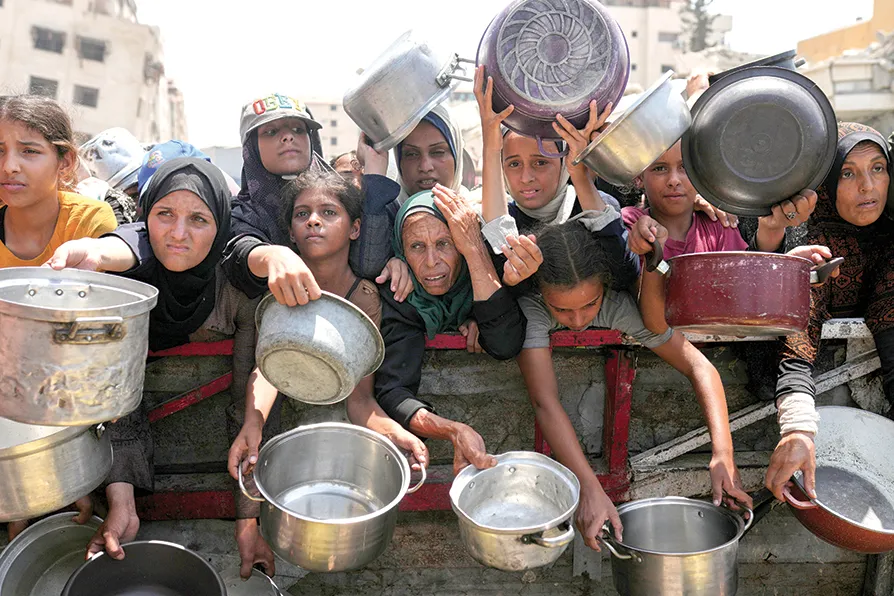1943-2025: How one man’s unfinished work reveals the lethal lie of ‘colour-blind’ medicine
ROX MIDDLETON, LIAM SHAW and MIRIAM GAUNTLETT delve into the technicalities of famine classification to reveal a worldview in tatters

 Palestinians struggle to get donated food at a community kitchen in Gaza City, northern Gaza Strip, Saturday August 16 2025
Palestinians struggle to get donated food at a community kitchen in Gaza City, northern Gaza Strip, Saturday August 16 2025
LAST week, the media reported that famine had been declared in Gaza by the Integrated Food Security Phase Classification (IPC). Confusingly, that acronym defines both a classification scheme and an organisation in its own right.
The IPC is an international hodgepodge. Founded in 2004 and funded by the EU and the governments of Britain, Canada and Germany, there are 21 different organisations involved in its governance.
These range from charities like Save the Children and Oxfam, to intergovernmental bodies like the WHO, Unicef and the World Bank, to “co-ordination mechanisms” like the Global Nutrition Cluster – which itself is co-ordinated by Unicef but has multiple stakeholders including, recursively, some of the other organisations that govern the IPC.
Within the complex bureaucratic tangles that shape the international aid landscape, the IPC aims to use a consistent set of rules to assess food insecurity.
For each analysis, a strict protocol sets out how to proceed, for example mandating that the “IPC Analysis Team Composition Matrix” must be completed to aid the selection of analysts. These analysts then use data fed in by aid agencies that support the IPC to classify food crises on a scale of “Phases” from 1 to 5 – with 5 being the most serious.
IPC Phase 5 is described with the dual term “Catastrophe/Famine.” That’s because under the IPC criteria, it’s still possible for people to be in Phase 5, literally starving, without the situation’s technical definition as “a famine.”
There are further criteria on top of that for defining that scenario: in a given region there must be 20 per cent of households with no access to food, 30 per cent of children suffering severe acute malnutrition and more than two people per 10,000 dying – all at the same time. Otherwise, it’s not a famine, only a catastrophe.
The justification is that by following technical and consistent criteria to define “famine,” the IPC provides a rational and apolitical basis for distributing aid.
As Joshua Craze put it, writing in 2024 in New Left Review, “Merely to name a famine, the humanitarian appeals suggest, will awaken the world’s conscience and unlock the pockets of the donors.”
Clearly, the IPC use of “famine” rests on an arbitrary definition. There’s nothing wrong in principle with arbitrary definitions – it’s hard to convert numerical descriptions into words without them – but its tight-lipped refusal to declare famines risks giving the wrong impression.
Have there really only been four famines since 2004, as its assessments suggest? As the director of the World Peace Foundation Alex de Waal has pointed out, the IPC declared a famine in certain regions of South Sudan in 2017, where several thousand people died. But in other surrounding regions which were classed by the IPC only as Phase 4, an estimated 190,000 people died of hunger and disease.
The IPC is not responsible for the devastating crises it quantifies. But its approach implicitly indicates that the international order is external to the conflict. Of course, that’s never the case.
That in itself isn’t a reason to ignore the IPC and its classifications, but what’s more problematic, in the IPC’s own terms, is the way its methodology relies on aid agencies to provide it with data.
Gaza presents an appalling challenge to that methodology. Last year 344 aid workers were killed worldwide; 204 of them were killed in Palestine.
So flagrantly has Israel prevented aid agencies from operating – stopping aid workers from entering, starving and killing those who do – that the prospect of adequate data being available seems remote. Without data the IPC cannot make its assessments.
Nevertheless, according to the IPC, there is now enough evidence to declare famine in Gaza. Many news organisations reported this as a shocking revelation.
Predictably, Israel’s government has rubbished the claim of famine. (When we Googled the phrase “famine IPC report,” the sponsored result at the top of the page was from an Israeli government website that attacks the IPC and brands its work “Politics Disguised as Science.”)
Disgracefully, a major talking point of these bogus criticisms is the paucity of data – a paucity that Israel has deliberately created.
This controversy over whether or not there is “famine” in Gaza is both manufactured and irrelevant. Already in November 2023, aid agencies were able to use a brief ceasefire to collect enough data for the IPC to make an assessment, finding that 93 per cent of Gaza’s population were in IPC Phase 3 or above — meaning they weren’t getting enough food — the worst level the IPC had ever recorded in any crisis. And already, 17 per cent were in Phase 5.
That wasn’t quite enough evidence to declare a famine, as per IPC definition. But to give the IPC its due, it had already performed its intended function and sounded the alarm. It was just that most governments didn’t want to hear it.
In the most recent IPC report, the language remains careful and judicious. Despite now classifying some regions of Gaza as in famine, others are still excluded: for North Gaza, the analysis team requested guidance on whether they should classify it as Phase 5; the committee that reviewed their work recommended “not to classify.”
This prudent language leaves a lot unsaid – chiefly, that the worldview the IPC represents is in tatters.
Many working in international aid have emphasised that Israeli weaponisation of famine in Gaza has made a mockery of the principles they believe in.
Francesco Checchi, an epidemiologist who has completed multiple studies on Gaza, has written that “a precedent is being established and indeed crossed, stress-tested and updated by Israel on a daily basis… for the effective nullification of public health and humanitarian principles and imperatives.”
In a neoliberal worldview, famines are meant to be tragic, quasi-unavoidable things that happen at the dark edges of the international order by accident, not design. The IPC was created to alert liberal democracies to those aberrations. But now famine deaths are rising around the world, and not only in Gaza.
The genocide in Gaza has rightly received attention, but since 2020, other man-made famines in Sudan, Yemen and Ethiopia have killed more than 200,000 people a year.
The genocide in Gaza exposes the blatant falsity of the neoliberal worldview. It is not simply that this famine is entirely man-made, nor that starvation of civilians is being used as a method of warfare, nor even that the situation has been abundantly clear for almost two years.
It is the unavoidable fact that this famine has been created by a close ally of the very governments that fund the IPC. Without the complicity of those governments, it would have never got to this stage.










